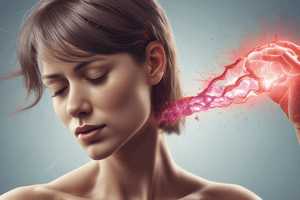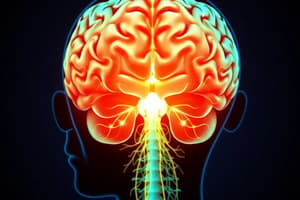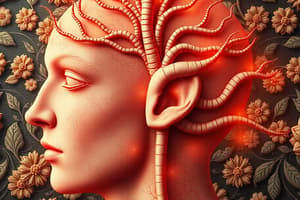Podcast
Questions and Answers
Which of the following is NOT a feature of trigeminal autonomic cephalgias?
Which of the following is NOT a feature of trigeminal autonomic cephalgias?
- Short-lasting headache
- Severe, unilateral headache
- Throbbing pain (correct)
- Ipsilateral ANS symptoms
Cluster headaches typically occur more frequently in females than males.
Cluster headaches typically occur more frequently in females than males.
False (B)
What is the duration range of a typical cluster headache attack?
What is the duration range of a typical cluster headache attack?
15 minutes to 3 hours
Cluster headaches are often associated with _________ ANS symptoms.
Cluster headaches are often associated with _________ ANS symptoms.
Match the types of trigeminal autonomic cephalgias with their characteristics:
Match the types of trigeminal autonomic cephalgias with their characteristics:
What is the fastest type of hypersynchronous neuronal motor activity?
What is the fastest type of hypersynchronous neuronal motor activity?
Pseudo seizures primarily occur in adults.
Pseudo seizures primarily occur in adults.
What does 'LOC' stand for in seizure classification?
What does 'LOC' stand for in seizure classification?
An atonic seizure is characterized by _____ motor activity.
An atonic seizure is characterized by _____ motor activity.
Match the types of seizures with their characteristics:
Match the types of seizures with their characteristics:
What is the most common treatment option for managing increased intracranial pressure?
What is the most common treatment option for managing increased intracranial pressure?
Pulsatile tinnitus is the most common type of tinnitus.
Pulsatile tinnitus is the most common type of tinnitus.
What type of headache is characterized as orthostatic and worsens in the morning?
What type of headache is characterized as orthostatic and worsens in the morning?
The best option for repeated lumbar puncture can extract up to ____ ml of cerebrospinal fluid.
The best option for repeated lumbar puncture can extract up to ____ ml of cerebrospinal fluid.
Match the symptoms with their appropriate descriptions:
Match the symptoms with their appropriate descriptions:
What type of seizure involves impaired awareness or dyscognition?
What type of seizure involves impaired awareness or dyscognition?
Simple Partial seizures exhibit loss of consciousness.
Simple Partial seizures exhibit loss of consciousness.
What types of seizures may be classified as generalized onset?
What types of seizures may be classified as generalized onset?
A diagnosis of epilepsy requires at least ______ unprovoked seizures separated by a minimum of 24 hours.
A diagnosis of epilepsy requires at least ______ unprovoked seizures separated by a minimum of 24 hours.
Match the following types of seizures with their characteristics:
Match the following types of seizures with their characteristics:
What is the main treatment option for trigeminal neuralgia?
What is the main treatment option for trigeminal neuralgia?
Trigeminal neuralgia can present with unilateral pain due to compression on the inferior cerebellar artery.
Trigeminal neuralgia can present with unilateral pain due to compression on the inferior cerebellar artery.
What is tic douloureux in the context of trigeminal neuralgia?
What is tic douloureux in the context of trigeminal neuralgia?
In benign intracranial hypertension, the __________ is often performed to assess brain abnormalities.
In benign intracranial hypertension, the __________ is often performed to assess brain abnormalities.
Match the following conditions with their features:
Match the following conditions with their features:
What does a normal MRI indicate in the evaluation of papilledema?
What does a normal MRI indicate in the evaluation of papilledema?
Bradycardia is a condition often associated with papilledema.
Bradycardia is a condition often associated with papilledema.
What is the opening pressure in a lumbar puncture that indicates papilledema?
What is the opening pressure in a lumbar puncture that indicates papilledema?
________ can occur as a secondary cause of papilledema due to drug use.
________ can occur as a secondary cause of papilledema due to drug use.
Match the secondary causes of papilledema with their categories:
Match the secondary causes of papilledema with their categories:
What is the primary characteristic of focal seizures without dyscognition?
What is the primary characteristic of focal seizures without dyscognition?
Focal seizures with dyscognition often involve loss of consciousness.
Focal seizures with dyscognition often involve loss of consciousness.
Name one structural lesion that can cause focal seizures.
Name one structural lesion that can cause focal seizures.
The most common localization for focal seizures with dyscognition is the _____ lobe.
The most common localization for focal seizures with dyscognition is the _____ lobe.
Match the following seizure types with their characteristics:
Match the following seizure types with their characteristics:
What is the typical age range for childhood absence seizures?
What is the typical age range for childhood absence seizures?
Post-ictal confusion is often present in typical childhood absence seizures.
Post-ictal confusion is often present in typical childhood absence seizures.
What is associated with genetically determined epilepsy in childhood?
What is associated with genetically determined epilepsy in childhood?
The EEG findings for generalized seizures in the temporal lobe show __________ spikes.
The EEG findings for generalized seizures in the temporal lobe show __________ spikes.
Match the following seizure types with their characteristics:
Match the following seizure types with their characteristics:
What is the primary treatment for typical juvenile absent seizures?
What is the primary treatment for typical juvenile absent seizures?
Atypical juvenile absent seizures are characterized by a normal EEG pattern.
Atypical juvenile absent seizures are characterized by a normal EEG pattern.
What is the age range associated with juvenile myoclonic epilepsy?
What is the age range associated with juvenile myoclonic epilepsy?
The aggravating factor for absent-mindedness and loss of focus in seizures is __________.
The aggravating factor for absent-mindedness and loss of focus in seizures is __________.
Match the seizure types with their characteristics:
Match the seizure types with their characteristics:
What is the primary treatment for paroxysmal hemicrania?
What is the primary treatment for paroxysmal hemicrania?
SUNT is characterized by unilateral, orbital or temporal pain with a high frequency of attacks.
SUNT is characterized by unilateral, orbital or temporal pain with a high frequency of attacks.
What is the recommended dose of oxygen for acute treatment?
What is the recommended dose of oxygen for acute treatment?
The best long-term prevention treatment for cluster headaches is __________.
The best long-term prevention treatment for cluster headaches is __________.
Match the types of headache disorders with their characteristics:
Match the types of headache disorders with their characteristics:
Flashcards are hidden until you start studying
Study Notes
Trigeminal Autonomic Cephalgias
- Includes: Cluster headaches, Paroxysmal hemicrania, SUNCT, Hemicrania continua
- Features:
- Short-lasting, severe, unilateral, neuralgic headaches
- Ipsilateral autonomic nervous system (ANS) symptoms including: conjunctival congestion/lacrimation, nasal congestion/rhinorrhea, eyelid edema, and forehead and facial sweating
Cluster Headache
- More common in young males
- Features:
- Unilateral periorbital non-throbbing pain
- Stabbing, boring, non-throbbing pain
- Excruciating pain
- Ipsilateral ANS symptoms
- Nocturnal headaches
- Frequency: 1-8 attacks/day
- Symptom duration: 8-10 weeks followed by symptom-free period
- Attack duration: 15 minutes - 3 hours (average 30 minutes)
- Photophobia may be seen
- 20% cases are chronic
- Triggers: Alcohol
- Other symptoms: Forehead and facial flushing, sensation of fullness in ear, miosis and/or ptosis
- Treatment:
- Weight loss
- Acetazolamide (DOC)
- Topiramate
- Repeated lumbar puncture (up to 20-30 ml): Best option
- Surgery: Optic nerve sheath fenestrations, shunting
Paroxysmal Hemicrania
- Females = males
- Headache type: Throbbing, boring, stabbing
- Severity: Excruciating
- Frequency: 1-20 attacks/day
- Attack duration: 2-30 minutes (average 5 minutes)
- ANS symptoms present
- Treatment: Indomethacin (reduces frequency of attacks)
SUNCT
- Males = females
- Unilateral orbital or temporal pain
- Headache type: Stabbing/throbbing
- Frequency: 3-200 attacks/day
- Management:
- Treatment: IV lignocaine
- Prevention: Lamotrigine or topiramate
Hemicrania Continua
- More common in elderly females
- Continuous unilateral background headache with episodic TAC
- Migrainous features and ANS symptoms present
- Responsive to indomethacin
Management of Acute Increased Intracranial Pressure
- Elevate the head
- Administer mannitol
- Sedation
- Hyperventilation
- Pressor therapy to maintain Cerebral Perfusion Pressure (CPP) > 60 mmHg
Trigeminal Neuralgia
- Females > males, age 50-60 years
- Paroxysms of intense unilateral pain due to compression on superior cerebellar artery
- Bilateral pain due to demyelination (multiple sclerosis)
- Brief, electric, shock-like superficial pain
- Wincing due to pain (tic douloureux)
- Maxillary (V2) and mandibular (V3) division of trigeminal nerve
- No objective sensory loss
- Cutaneous trigger present, followed by a refractory period
- Investigation: Specialized MRI
- Treatment:
- Carbamazepine (most effective) >> lamotrigine
- HLA B-1502 testing before administration of carbamazepine
- Subcutaneous botulinum toxin
- Microvascular decompression in medical refractory cases
Glossopharyngeal Neuralgia
- Also known as Eagle syndrome
- Due to elongation of styloid process
- Sudden, severe, short-lasting, recurrent bouts of pain
- Pain location: Tonsil bed, throat & angle of jaw
- Aggravation factors: Coughing, yawning, swallowing
- Associated with cardiac conduction abnormalities
Benign Intracranial Hypertension (Idiopathic Intracranial Hypertension)
- Often seen with hypertension, bradycardia, and bradypnoea
- Evaluation protocol: Papilledema and no neurological signs except possible 6th nerve paresis
- Diagnostic tests:
- MRI: Normal findings indicate possible benign intracranial hypertension or IIH
- CT/MRI: Normal results
- LP (Lumbar Puncture): Opening pressure greater than 25 cm of H₂O, normal CSF biochemistry and cytology
- Modified Dandy Criteria:
- Symptoms consistent with increased intracranial pressure
- No localizing signs other than possible 6th nerve palsy
- Normal CT and MRI findings
Papilledema
- Primary Empty Sella Syndrome: Benign intracranial hypertension with intact pituitary gland
- Secondary Causes:
- Drugs: Outdated tetracycline, nalidixic acid, NSAIDs, retinol, danazol, tamoxifen
- Endocrine: Steroid withdrawal, growth hormone, anabolic steroids
Seizure Semiology
- Definition: signs and symptoms of seizure activity
- Seizure: Transient occurrence of signs and/or symptoms due to abnormal excessive hypersynchronous neuronal activity in the brain
- Hypersynchronous neuronal motor activity:
- Myoclonic (fastest)
- Clonic
- Tonic
- Atonic (slowest)
Pseudo seizure
- Most common in adolescents
- Increased axial thrust movements
- Increased attention-seeking actions
- Pupils: Low sympathetic activity → Less dilation
Classification (ILAE 2017)
- Based on onset: Focal, Generalized (with/without loss of consciousness), Unknown
- Focal Onset (Partial):
- Complex Partial: Impaired awareness, automatisms, non-motor symptoms
- Simple Partial: Absent (absence of loss of consciousness), tonic, clonic, atonic, myoclonic, hyperkinetic, epileptic spasm (rare)
- Generalized Onset:
- Motor: Tonic clonic, clonic, tonic, myoclonic, atonic
- Non-motor: Typical absent, atypical absent, myoclonic
Epilepsy
- Evaluation:
- MRI
- EEG
- Type of onset
- Loss of consciousness
- Epilepsy Syndrome:
- At least two unprovoked seizures separated by at least 24 hours without an identifiable cause
- Single episode seizure with evidence suggestive of epileptiform syndrome on MRI/EEG with a risk of subsequent seizure >60%
- Investigation of TAC:
- MRI brain
- Polysomnography
- Pituitary function test
Focal Seizures
- Without Dyscognition: Simple partial seizure, focal motor onset, aware, no epileptiform syndrome
- With Dyscognition: Complex partial seizure, focal motor or non-motor onset, impaired consciousness, post-ictal disorientation, epileptiform syndrome present, medial temporal lobe is the most common location
- Etiology:
- Structural lesion (frontal/fronto-parietal lobe) → Opposite side brain irritation → Seizure
- Tuberculoma
- Neurocysticercosis
- Brain tumors
- Post-stroke seizure (elderly)
- Motor (Tonic > Tonic clonic) > sensory (flashing light) / Autonomic
- Presentation:
- Clonic movements: 2-3 Hz
- Abnormal facial movements synchronized with limbs
- Todd's palsy: Post-ictal (transient) palsy lasting up to 24 hours
- Jacksonian march: Motor activity migration (Distal to proximal)
- Epilepsia partialis continua: Continuous activity lasting hours to days
- Aura: Rare
- MRI: Determine etiology, Normal results may indicate transient abnormality → Not diagnostic
- EEG: Not an indication for anti-epileptics
- Treatment:
- Most common type of complex partial seizure
- Family history present
- History of febrile seizures in childhood
- EEG: Temporal spikes
- Other Observations:
- Family history present
- Aura: Subjective internal event not observed by others, Abdominal (Feeling of fullness → Regurgitation) > visual > auditory
- Behavioral arrest: Motionless stare
- Automatisms: Coordinated motor activity resembling movement (e.g., Lip smacking, chewing)
- Anterograde amnesia
- Hippocampal sclerosis
- Temporal spikes
- Antiepileptics: Lifelong
Generalized Seizures
- Absent Seizures: Non-motor, Epileptiform syndromes: Typical childhood absence seizure (remission by 12 years, good prognosis), Atypical juvenile absence seizure
- Typical childhood absent seizures:
- Age: 4-10 years
- Gender: Boys > Girls
- Presentation:
- Consciousness: Sudden brief lapse (No loss of postural control)
- Post-ictal confusion: Absent
- MRI: Hippocampal sclerosis
- EEG: Temporal lobe spikes
- Atypical Juvenile Absent Seizure:
- Age: 9-13 years
- Presentation:
- Loss of consciousness: Longer duration
- Loss of postural control
- Status epilepticus
- EEG: Asymmetrical slow spike and wave pattern, abnormal interictal background
- Treatment: Antiepileptic drugs (lifelong), Valproate (preferred), ethosuximide
- Typical childhood absent seizures:
- Generalized Tonic Clonic Seizures:
- Juvenile Myoclonic Epilepsy
- Age: 6-25 years
- Gender: Females > males
- Associations: Sleep deprivation (upon awakening), GTCS in 90%, Absence seizure in 1/3rd cases
- Juvenile Myoclonic Epilepsy
Active Space Management
- Treatment: 100% Oxygen (treatment of choice), 12-15 L/min for 10-20 minutes, Sumatriptan 6 mg s/c
- Prevention:
- Short-term: Steroids (DOC), Verapamil, Galcanezumab, Greater occipital nerve injection
- Long-term: Verapamil (best), Topiramate, Lithium
Neurology
- Active Space:
- IQ: Normal
- Daydreaming, absentmindedness, loss of focus
- Motor activity: Pause/stare > automatisms > eye movement
- Aggravating factor: Hyperventilation
- Investigations:
- MRI: Normal
- EEG: 3Hz spike & wave pattern
- Treatment:
- Antiepileptic drugs until age 12 (remission, good prognosis)
- Valproate (preferred), ethosuximide
Studying That Suits You
Use AI to generate personalized quizzes and flashcards to suit your learning preferences.




